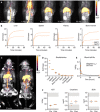A modular approach toward producing nanotherapeutics targeting the innate immune system
- PMID: 33674313
- PMCID: PMC7935355
- DOI: 10.1126/sciadv.abe7853
A modular approach toward producing nanotherapeutics targeting the innate immune system
Abstract
Immunotherapies controlling the adaptive immune system are firmly established, but regulating the innate immune system remains much less explored. The intrinsic interactions between nanoparticles and phagocytic myeloid cells make these materials especially suited for engaging the innate immune system. However, developing nanotherapeutics is an elaborate process. Here, we demonstrate a modular approach that facilitates efficiently incorporating a broad variety of drugs in a nanobiologic platform. Using a microfluidic formulation strategy, we produced apolipoprotein A1-based nanobiologics with favorable innate immune system-engaging properties as evaluated by in vivo screening. Subsequently, rapamycin and three small-molecule inhibitors were derivatized with lipophilic promoieties, ensuring their seamless incorporation and efficient retention in nanobiologics. A short regimen of intravenously administered rapamycin-loaded nanobiologics (mTORi-NBs) significantly prolonged allograft survival in a heart transplantation mouse model. Last, we studied mTORi-NB biodistribution in nonhuman primates by PET/MR imaging and evaluated its safety, paving the way for clinical translation.
Copyright © 2021 The Authors, some rights reserved; exclusive licensee American Association for the Advancement of Science. No claim to original U.S. Government Works. Distributed under a Creative Commons Attribution NonCommercial License 4.0 (CC BY-NC).
Figures





Similar articles
-
Embracing nanomaterials' interactions with the innate immune system.Wiley Interdiscip Rev Nanomed Nanobiotechnol. 2021 Nov;13(6):e1719. doi: 10.1002/wnan.1719. Epub 2021 Apr 13. Wiley Interdiscip Rev Nanomed Nanobiotechnol. 2021. PMID: 33847441 Free PMC article. Review.
-
Targeting mTOR in myeloid cells prevents infection-associated inflammation.iScience. 2025 Mar 4;28(4):112163. doi: 10.1016/j.isci.2025.112163. eCollection 2025 Apr 18. iScience. 2025. PMID: 40177636 Free PMC article.
-
High-Density Lipoprotein Nanobiologics for Precision Medicine.Acc Chem Res. 2018 Jan 16;51(1):127-137. doi: 10.1021/acs.accounts.7b00339. Epub 2017 Dec 27. Acc Chem Res. 2018. PMID: 29281244 Free PMC article. Review.
-
Trained Immunity-Promoting Nanobiologic Therapy Suppresses Tumor Growth and Potentiates Checkpoint Inhibition.Cell. 2020 Oct 29;183(3):786-801.e19. doi: 10.1016/j.cell.2020.09.059. Cell. 2020. PMID: 33125893 Free PMC article.
-
Inhibiting Inflammation with Myeloid Cell-Specific Nanobiologics Promotes Organ Transplant Acceptance.Immunity. 2018 Nov 20;49(5):819-828.e6. doi: 10.1016/j.immuni.2018.09.008. Epub 2018 Nov 6. Immunity. 2018. PMID: 30413362 Free PMC article.
Cited by
-
Novel impact of metal ion-induced cell death on diabetic cardiomyopathy pathogenesis and therapy.Apoptosis. 2025 Jun;30(5-6):1152-1181. doi: 10.1007/s10495-025-02090-4. Epub 2025 Mar 5. Apoptosis. 2025. PMID: 40042744 Review.
-
Radiolabeling lipoproteins to study and manage disease.Eur J Nucl Med Mol Imaging. 2025 Apr 28:10.1007/s00259-025-07281-4. doi: 10.1007/s00259-025-07281-4. Online ahead of print. Eur J Nucl Med Mol Imaging. 2025. PMID: 40293448 Free PMC article. Review.
-
Trained immunity is regulated by T cell-induced CD40-TRAF6 signaling.Cell Rep. 2024 Sep 24;43(9):114664. doi: 10.1016/j.celrep.2024.114664. Epub 2024 Aug 22. Cell Rep. 2024. PMID: 39178113 Free PMC article.
-
Embracing nanomaterials' interactions with the innate immune system.Wiley Interdiscip Rev Nanomed Nanobiotechnol. 2021 Nov;13(6):e1719. doi: 10.1002/wnan.1719. Epub 2021 Apr 13. Wiley Interdiscip Rev Nanomed Nanobiotechnol. 2021. PMID: 33847441 Free PMC article. Review.
-
Negative Vaccination Strategies for Promotion of Transplant Tolerance.Transplantation. 2024 Aug 1;108(8):1715-1729. doi: 10.1097/TP.0000000000004911. Epub 2024 Feb 16. Transplantation. 2024. PMID: 38361234 Free PMC article. Review.
References
-
- Braza M. S., van Leent M. M. T., Lameijer M., Sanchez-Gaytan B. L., Arts R. J. W., Pérez-Medina C., Conde P., Garcia M. R., Gonzalez-Perez M., Brahmachary M., Fay F., Kluza E., Kossatz S., Dress R. J., Salem F., Rialdi A., Reiner T., Boros P., Strijkers G. J., Calcagno C. C., Ginhoux F., Marazzi I., Lutgens E., Nicolaes G. A. F., Weber C., Swirski F. K., Nahrendorf M., Fisher E. A., Duivenvoorden R., Fayad Z. A., Netea M. G., Mulder W. J. M., Ochando J., Inhibiting inflammation with myeloid cell-specific nanobiologics promotes organ transplant acceptance. Immunity 49, 819–828.e6 (2018). - PMC - PubMed
-
- Saeed S., Quintin J., Kerstens H. H. D., Rao N. A., Aghajanirefah A., Matarese F., Cheng S.-C., Ratter J., Berentsen K., van der Ent M. A., Sharifi N., Janssen-Megens E. M., Huurne M. T., Mandoli A., van Schaik T., Ng A., Burden F., Downes K., Frontini M., Kumar V., Giamarellos-Bourboulis E. J., Ouwehand W. H., van der Meer J. W. M., Joosten L. A. B., Wijmenga C., Martens J. H. A., Xavier R. J., Logie C., Netea M. G., Stunnenberg H. G., Epigenetic programming of monocyte-to-macrophage differentiation and trained innate immunity. Science 345, 1251086 (2014). - PMC - PubMed
-
- Zhao Y., Fay F., Hak S., Perez-Aguilar J. M., Sanchez-Gaytan B. L., Goode B., Duivenvoorden R., de Lange Davies C., Bjørkøy A., Weinstein H., Fayad Z. A., Pérez-Medina C., Mulder W. J. M., Augmenting drug–carrier compatibility improves tumour nanotherapy efficacy. Nat. Commun. 7, 11221 (2016). - PMC - PubMed
Publication types
MeSH terms
Substances
Grants and funding
LinkOut - more resources
Full Text Sources
Other Literature Sources
Medical
Research Materials
Miscellaneous

